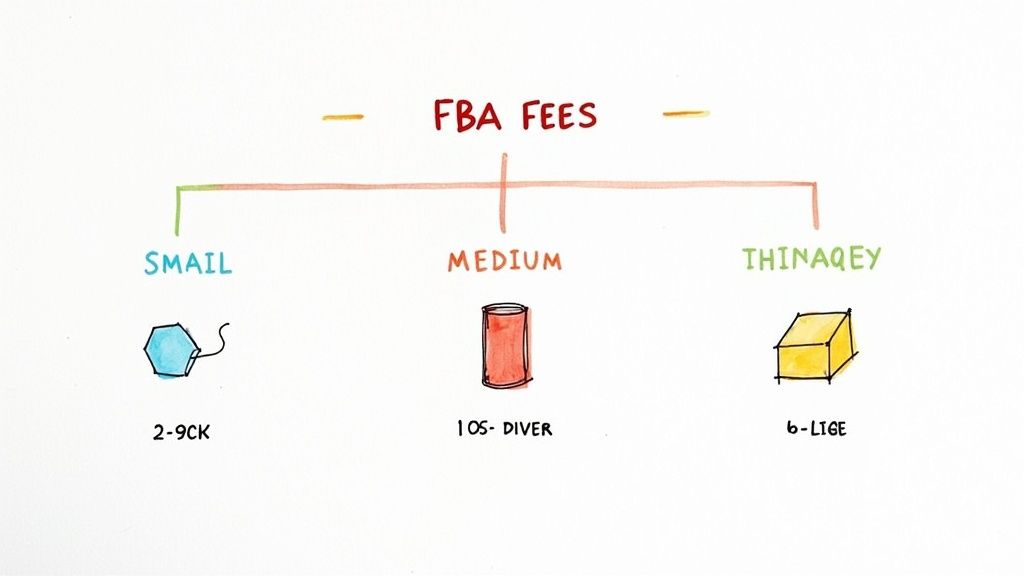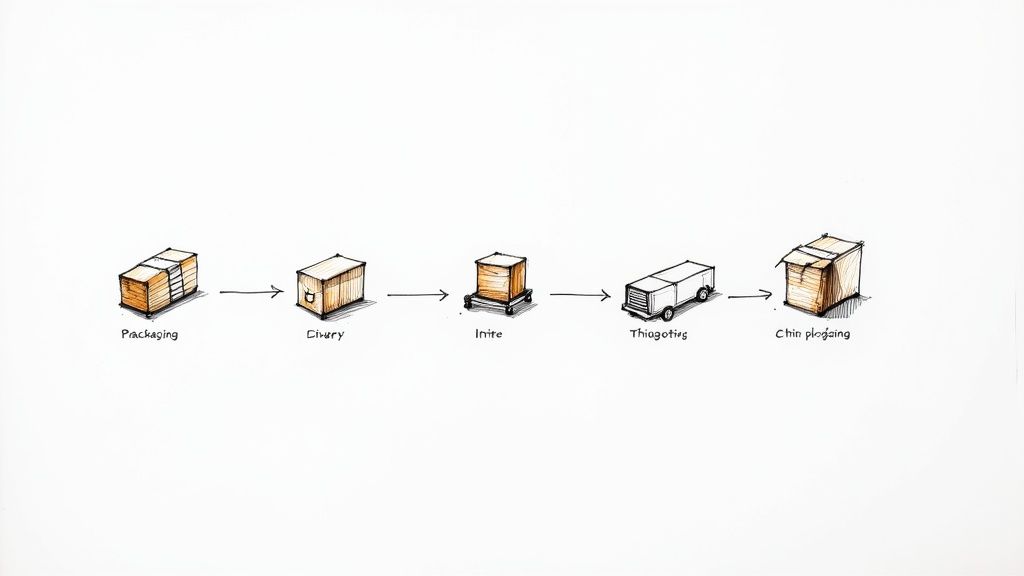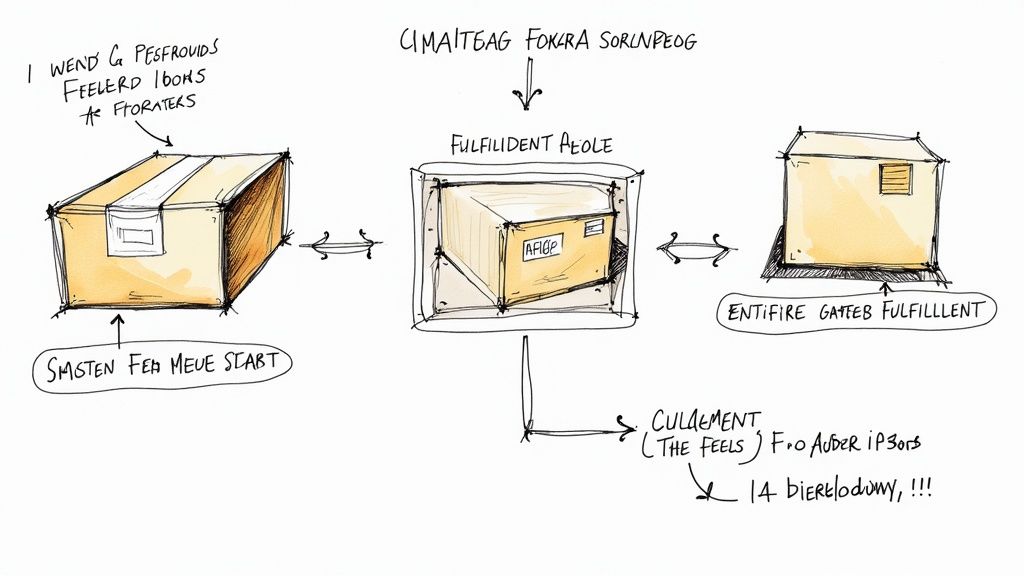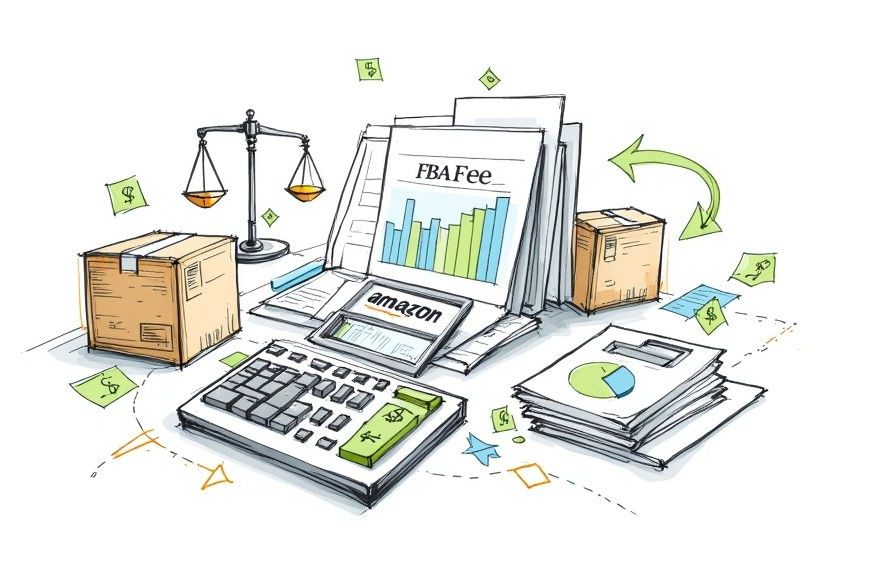Breaking Down the True Cost of FBA Fees

Accurate fee calculation is essential for any seller looking to build a sustainable business on Amazon. Many sellers focus only on product costs and sales prices, but the real impact comes from understanding every fee that impacts your margins. By breaking down each component, you can make smarter decisions about pricing and inventory management.
Key Components of FBA Fees
Several core fees make up your total FBA costs:
- Referral Fees: These are Amazon’s commissions on each sale, usually around 15% of the selling price but varying by category. For instance, if you sell a $50 item, you’ll pay $7.50 in referral fees at the 15% rate.
- Fulfillment Fees: These cover Amazon’s costs for storing, picking, packing, shipping and customer service. The fees are based on size and weight – a standard one-pound item typically costs between $2.41-$4.71 to fulfill.
- Storage Fees: You pay these monthly for storing inventory in Amazon’s warehouses. The rates change between peak and off-peak seasons. For example, 100 units taking up 0.5 cubic feet each would cost $37.50 per month during peak season.
While each fee seems simple on its own, they interact in ways that can significantly affect profits. A slightly larger product could bump you into a higher fulfillment fee tier and eat into your margins. This is why successful sellers look at fees as an interconnected system rather than individual costs.
Common Misconceptions and Their Impact
Many sellers make costly mistakes when calculating their FBA fees. One frequent error is not accounting for how product dimensions affect fulfillment costs – even small size increases can trigger much higher fees. Another oversight is underestimating storage fees, especially during Q4 when rates nearly triple. For slow-moving inventory, these fees compound month after month and can turn a profitable product into a money-losing one.
Practical Frameworks for Understanding Your True Costs
Smart sellers use specific tools and methods to master their fee calculations. They rely on the Amazon FBA Fee Calculator to model different scenarios and identify the most profitable options. Beyond tools, they actively track their fees over time, looking for opportunities to reduce costs by adjusting packaging or improving inventory turn rates. This data-driven approach helps them maintain healthy margins even as fees change. By understanding how fees work together, you can make strategic decisions that protect and grow your profits on Amazon.
Make Better Decisions with the FBA Calculator

Making smart choices about your Amazon business requires accurate fee calculations. Small mistakes in estimating FBA costs can seriously impact your profits. The Amazon FBA Calculator helps sellers forecast these expenses and determine if products will be profitable before making inventory investments.
Using the Calculator Effectively
Getting the most from the FBA Calculator starts with understanding how to input data and interpret results. Think of it as a testing ground where you can model different scenarios. The key information you’ll need includes your product measurements, weight, target price, and shipping details.
For instance, let’s say you want to sell ceramic coffee mugs. You’ll need exact packaging dimensions and weight since even small differences can bump you into a higher fee tier and reduce margins. Your selling price affects referral fees, while shipping choices impact fulfillment costs.
The calculator then shows a detailed breakdown of estimated FBA fees – including referral fees, fulfillment charges, and monthly storage costs. Understanding each component helps you spot areas to reduce expenses. This granular view of costs is essential for making informed business decisions.
Avoiding Key Mistakes
New sellers often make some common errors when using the calculator. A big one is forgetting to account for packaging – Amazon bases fees on the packaged dimensions and weight, not just the bare product. Another oversight is not checking for fee updates. Amazon adjusts rates periodically, so staying current is important.
Some sellers also focus only on the total fee amount. While the overall cost matters, examining each fee component reveals chances to optimize. You might find ways to reduce dimensional weight through better packaging or adjust pricing to improve profitability after fees.
Smart Calculator Strategies
Experienced sellers use several advanced techniques with the FBA Calculator:
- Compare Product Options: Input specs for different variations to see which size or style offers the best margin after fees. For example, testing various mug sizes shows which ones are most profitable.
- Plan for Peak Seasons: With higher storage fees during busy periods, use the calculator to model seasonal impacts and adjust inventory plans.
- Test Price Points: Try different selling prices to find the sweet spot between competitiveness and profitability after fees. This data-driven approach helps set optimal prices.
The FBA Calculator is more than just a math tool – it’s key for making smart business choices. Understanding how to use it properly, avoiding common pitfalls, and applying advanced strategies helps you make decisions that support long-term success on Amazon. Regular and thoughtful use of the calculator is essential as you grow your business in Amazon’s competitive marketplace.
Mastering Size and Weight Classifications

Knowing how to use the FBA Calculator is just the first step – to truly optimize your fees, you need a solid grasp of Amazon’s size and weight classifications. These categories determine your fulfillment costs and even small differences can significantly impact your profits. Let’s break down what you need to know to classify your products correctly and minimize your fees.
Understanding Size Tiers
Amazon organizes products into specific size categories, from small standard-size items like phone cases to special oversized products like furniture pieces. Each tier comes with its fee structure that directly affects your costs. The exact measurements and weight limits for each category are detailed in Seller Central, and since these can change periodically, it’s worth checking them regularly to stay up to date.
The Impact of Dimensional Weight
For larger or oddly shaped items, Amazon bases fees on dimensional weight rather than actual weight. This calculated weight often results in higher fees than you might expect. For example, a large but lightweight stuffed animal could cost more to ship than a smaller, heavier item due to the space it takes up. To figure out dimensional weight, multiply length x width x height in inches, then divide by 139. This simple calculation can help you anticipate your true shipping costs.
Optimizing Packaging for Lower Fees
Smart packaging choices can lead to substantial savings on FBA fees. A small reduction in package size might move your product into a lower fee tier, multiplying your savings across hundreds or thousands of units. Consider a product selling 1,000 units monthly – trimming just a few cents per unit by optimizing packaging size could save you hundreds of dollars each month. This makes package design a crucial factor in your profitability.
Practical Tips for Accurate Measurement
Getting accurate measurements is essential to avoid surprise fees. Start by investing in quality measuring tools and keeping detailed records of your packaged products’ dimensions. Remember – Amazon measures the complete package, not just the product inside. Take multiple measurements to ensure accuracy, and if you’re unsure, consider getting expert advice on proper measurement techniques. These seemingly minor details can have a major impact on your FBA costs over time.
Strategic Storage Management for Fee Reduction

Managing storage fees is critical for maintaining healthy profit margins as an Amazon seller. While calculating FBA fees and understanding size classifications are important first steps, the real challenge lies in strategically managing your inventory levels. You need to carefully balance having enough stock to meet customer demand without letting storage costs eat into your profits. Let’s explore some practical ways to achieve this balance.
Seasonal Planning for Inventory Control
Smart inventory planning requires understanding the natural cycles of customer demand throughout the year. For example, holiday products see huge spikes in Q4 (October-December), but storing large quantities during off-seasons means paying unnecessarily high storage fees. The key is accurately forecasting demand so you can stock up at the right times while minimizing warehouse storage time. This helps you avoid excess fees during slower seasons while ensuring you don’t miss sales during peak periods.
Inventory Rotation Strategies
Just like grocery stores rotate perishable items, Amazon sellers need systems to move older inventory first. Following FIFO (First-In, First-Out) principles helps prevent costly long-term storage fees that hurt your bottom line. By prioritizing the sale of inventory that’s been in warehouses longest, you reduce the risk of aging inventory surcharges. Understanding how these fees are calculated lets you factor storage costs into your pricing decisions and promotional planning.
Maintaining Optimal Stock Levels During Peak Periods
Managing inventory gets especially tricky during peak seasons when both sales volume and storage fees increase. Storage costs can triple during Q4, so overstocking can seriously impact your margins. However, running out of stock means missed sales and lower search rankings. The solution is using sales data to forecast demand accurately and maintaining just enough inventory to capture sales while keeping storage fees under control.
Real-World Examples and Actionable Strategies
Top sellers stay profitable by closely tracking key metrics like inventory turnover and days of supply. For instance, a patio furniture seller might increase stock before summer but run promotions in fall to clear aging inventory. They use data to know exactly when to stock up and when to reduce inventory through sales and promotions. This balanced approach – understanding fees, forecasting demand, and actively managing stock levels – is what drives long-term success of Amazon. The sellers who master these strategies are best positioned to grow profitably in Amazon’s competitive marketplace.
Building and Protecting Your Profit Margins
Successfully running an Amazon FBA business requires more than just calculating fees – you need a complete grasp of your finances and a plan to maintain strong profit margins despite market changes. Smart FBA sellers know that protecting profitability takes constant attention to costs and strategic pricing adjustments based on real data.
Integrating FBA Fees into Your Pricing Strategy
Setting prices that work requires looking beyond basic markups to find the right balance of profitability and market competitiveness. For instance, when pricing a handcrafted product, you need to account for all your FBA-related costs first – referral fees, fulfillment charges, and storage expenses – to determine your actual break-even point. Only then can you set prices that allow enough margin for promotions while staying profitable? This data-driven approach helps you make smart pricing decisions that work for both your business and your customers.
Adapting to Fee Changes and Market Shifts
The Amazon marketplace is always changing, from FBA fee updates to seasonal demand swings. Your initial fee calculations can quickly become outdated. Storage fees often rise during peak holiday periods, forcing sellers to adjust. Smart sellers plan for these changes – perhaps raising prices slightly during high-demand times to offset increased costs, or clearing inventory with promotions during slower periods to minimize storage expenses. The key is staying flexible and proactive.
Protecting Your Margins as Your Business Scales
As your sales grow, small changes in fees can have major effects on your bottom line. That’s why regular review of your fee calculations is essential – like checking your business foundation for weak spots before they become serious problems. Growing sellers should also look for ways to optimize, such as adjusting packaging to reduce dimensional weight and lower fulfillment costs. These small improvements add up to meaningful savings when applied across thousands of orders.
Real-World Pricing Strategies in Action
The most successful Amazon sellers treat fee management as an ongoing process, not a one-time task. They closely track their data to spot opportunities for improvement. Consider a seller of small electronics who discovers through analysis that slightly smaller packaging would qualify their products for lower FBA fees. While the per-unit savings may seem minor, multiplied across their full sales volume, it becomes significant. This kind of data-based approach to managing FBA fees sets apart sellers who maintain strong profits from those who struggle with tight margins. The winning formula combines smart initial planning with consistent monitoring and quick adaptation when market conditions change.
Advanced Fee Optimization Strategies That Work
Understanding the basics of FBA fees opens the door to more sophisticated cost-reduction techniques. Let’s explore proven strategies that successful Amazon sellers use to minimize their fulfillment expenses and boost their bottom line.
Product Bundling: More Than the Sum of Its Parts
Product bundling stands out as one of the most effective ways to reduce your per-unit FBA costs. Instead of shipping individual items separately, combining related products into a single package means you only pay one fulfillment fee rather than multiple fees. For small, lightweight items where fulfillment fees make up a bigger portion of costs, the savings can be substantial.
For example, a seller offering travel accessories could package sample-sized toiletries together instead of selling them individually. Not only does this reduce fulfillment fees, but it can also increase average order value while giving customers more value and convenience in a single purchase.
Multi-Channel Fulfillment: Expanding Your Reach While Optimizing Costs
Multi-Channel Fulfillment (MCF) provides another avenue for strategic cost reduction. While primarily designed for fulfilling orders from external sales channels through Amazon’s network, MCF can be used tactically to optimize specific FBA orders. This works particularly well for bulk orders or deliveries outside Amazon’s standard network.
For instance, a seller dealing with high storage fees for bulky seasonal items could use MCF to fulfill large orders directly from their warehouse during peak periods, bypassing Amazon storage fees entirely. The key is carefully comparing MCF and standard FBA fees for each scenario.
Inventory Placement Strategies: Getting Closer to Your Customers
Smart inventory placement can meaningfully impact your fulfillment costs. Through Amazon’s inventory placement program, sellers can influence where their products are stored within the fulfillment network. You can reduce transportation costs and delivery times by positioning inventory closer to your main customer bases.
While Amazon maintains primary control over final placement decisions, understanding the program’s options allows you to make strategic choices about inventory distribution, especially if you have high sales volumes in specific regions.
Adapting Strategies for Peak Seasons and Promotions
The most experienced sellers know that fee optimization requires different approaches during peak seasons and promotional periods. Storage fees increase during high-demand times like Q4, making efficient inventory management critical. Common tactics include modest price increases to offset higher fees or running targeted promotions to reduce inventory before peak storage rates take effect.
This flexible approach means continuously monitoring your inventory levels, analyzing sales patterns, and staying current on FBA fee changes. A seller might opt for smaller, more frequent shipments to Amazon’s warehouses during Q4 to minimize storage costs while maintaining adequate stock.
Successfully reducing your FBA costs requires implementing multiple strategies while closely tracking their effectiveness. Combining these proven techniques and regularly assessing their impact can reduce your fulfillment expenses and strengthen your competitive position.
Looking to recover additional revenue? Refunzo helps Amazon sellers identify and claim reimbursements for various FBA discrepancies.

